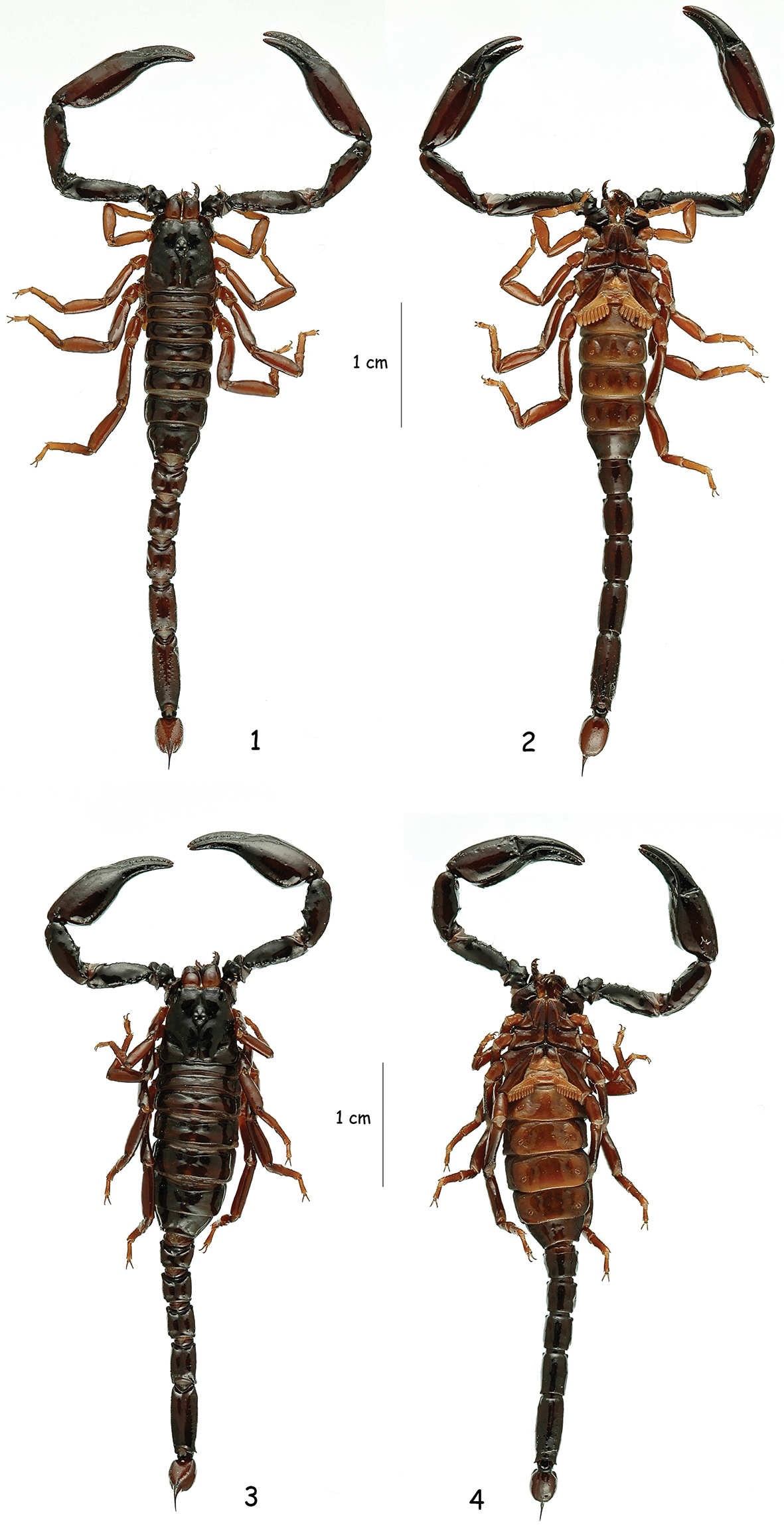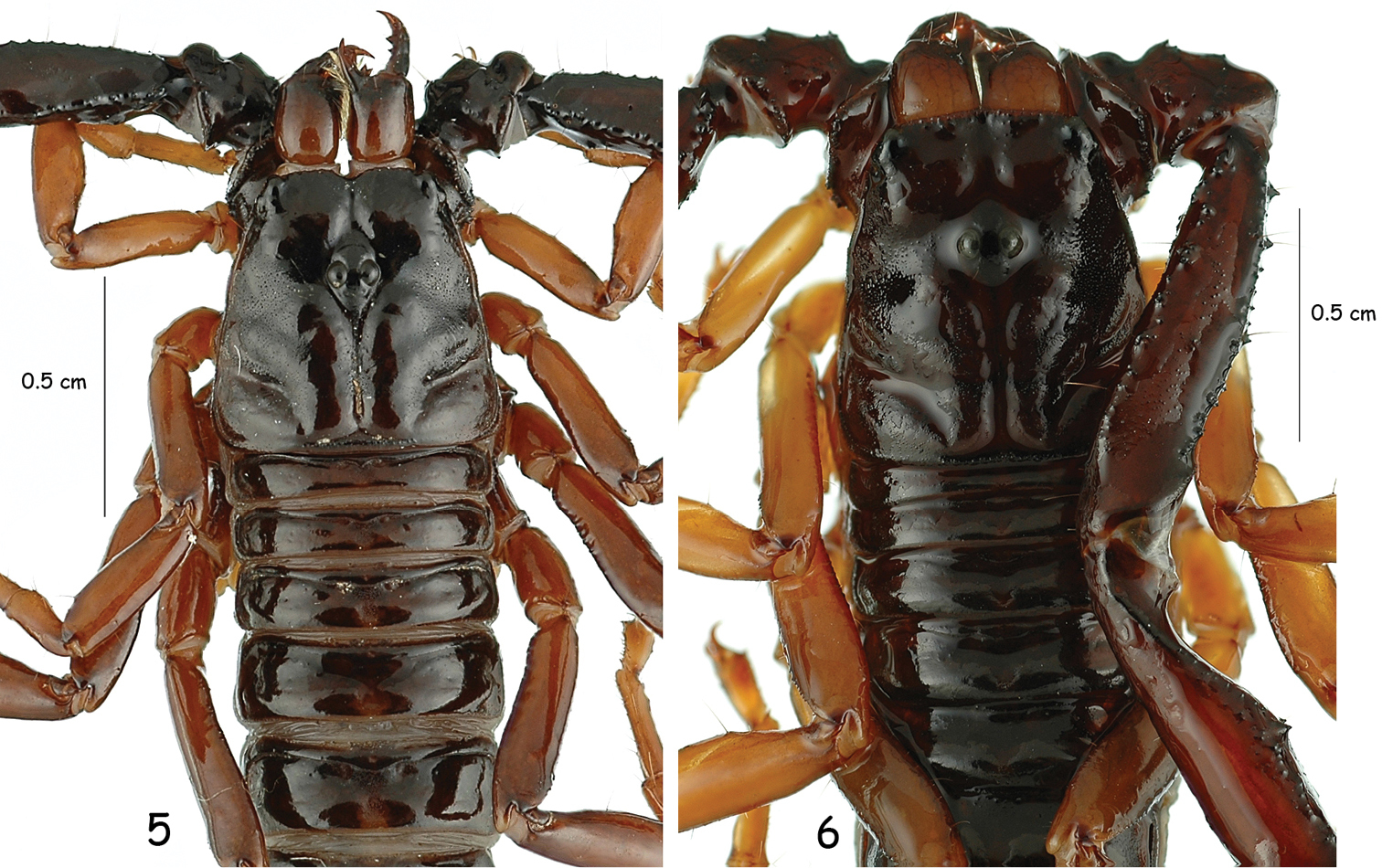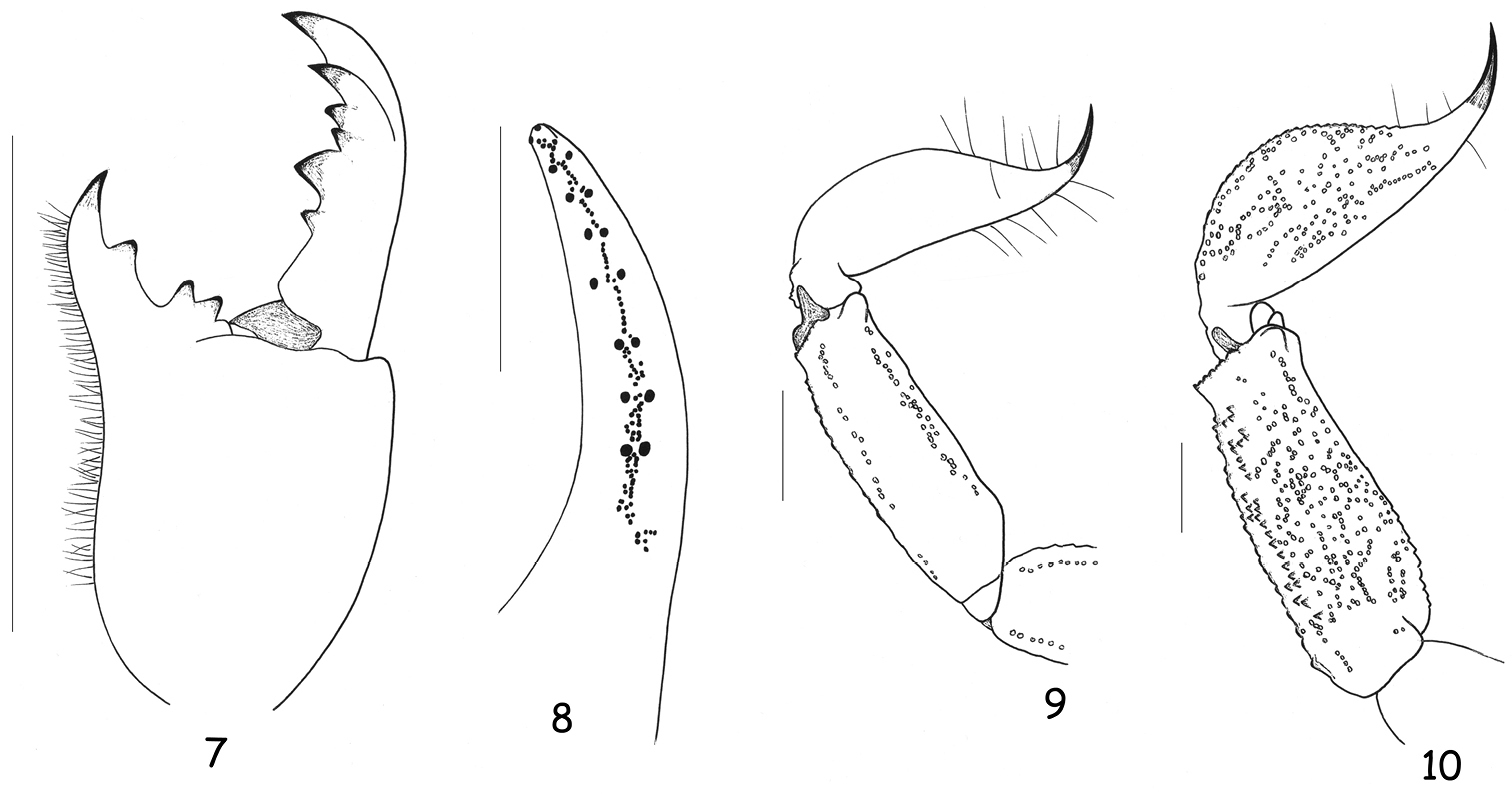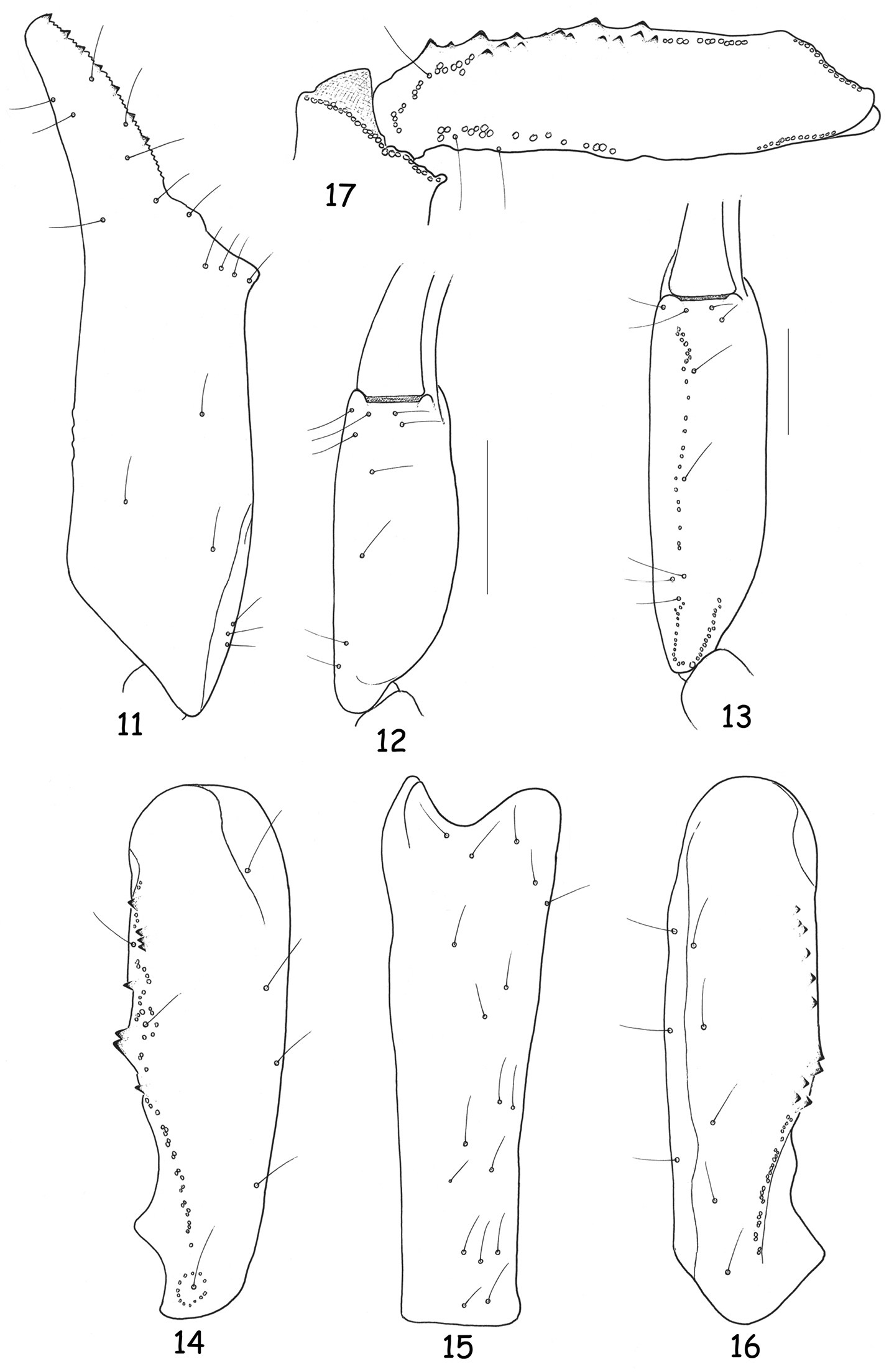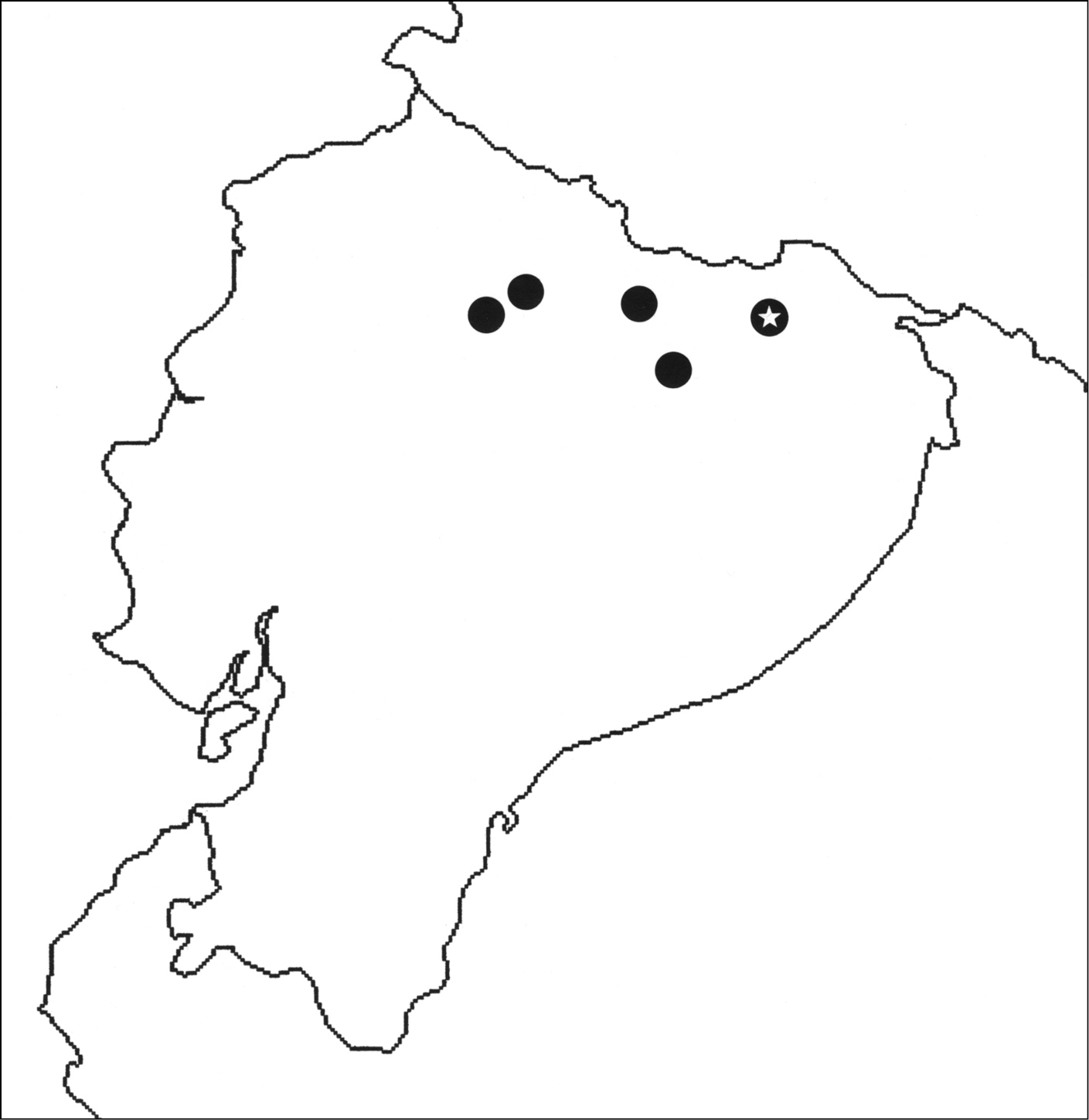






(C) 2014 Wilson R. Lourenço. This is an open access article distributed under the terms of the Creative Commons Attribution License (CC BY 4.0), which permits unrestricted use, distribution, and reproduction in any medium, provided the original author and source are credited.
For reference, use of the paginated PDF or printed version of this article is recommended.
Citation: Lourenço WR (2014) The second confirmed record of the scorpion genus Chactas Gervais, 1844 (Scorpiones, Chactidae) from Ecuador with description of a new species from the Amazonian Province of Sucumbíos. ZooKeys 372: 17–26. doi: 10.3897/zookeys.372.6665
A new species, Chactas moreti sp. n., is described from Ecuadorian Amazonia. It can be distinguished from Chactas mahnerti Lourenço, 1995, the other known species of this genus from Ecuador by its smaller body size, distinct morphometric values, overall darker blackish-brown coloration, totally smooth vesicle, and a concave anterior margin of carapace. This is the second confirmed record of the genus Chactas Gervais from Ecuador. The geographical pattern of distribution of the genus is also discussed.
Scorpiones, Chactas, new species, Ecuador, Amazon region, Province of Sucumbíos
The genus Chactas was created by
Even for the species described after Chactas vanbenedenii, the indication of precise localities was not common, and in some cases not even the original country was documented, (cf. Chactas chrysopus Pocock, 1893). Moreover, the original type materials are not always in a good state of preservation, further complicating a precise diagnosis of all species.
At present, the taxonomic classification of the genus Chactas is currently unresolved. This lack of clarification started a revision done by
In my previous analysis of the genus Chactas (Lourenço, 1997), I suggested that the single variation on the number of trichobothria should not be considered as a consistent character for the division of a genus into subgenera. Several other scorpion genera also exhibit significant variation in the number of trichobothria (e. g. Liocheles, Scorpiops, Euscorpiops etc.), which did not lead to divisions in subgenera. This suggestion was not, however, retained in the Catalog of the Scorpions of the World (
As for the varieties or subspecies suggested for the species Chactas lepturus, the question remains totally unresolved. A precise and detailed ecological study could led to a correct definition of their status as a polytypical or polymorphic species (
The pattern of distribution of the genus Chactas, seems to suggest a centre of dispersion in Colombia (
The first species described from Ecuador, Chactas camposi Mello-Leitão, 1939 was reported without any indication of a locality (
Illustrations and measurements were made with the aid of a Wild M5 stereo-microscope equipped with a drawing tube (camera lucida) and an ocular micrometer. Measurements follow
http://zoobank.org/8FDFBB1B-E14C-4A41-BBAA-A3EE95BEA6C7
http://species-id.net/wiki/Chactas_moreti
Figs 1–5, 7–9, 11–12, 14–17Ecuador, Province of Sucumbíus, San Pablo de Kantesiya, near to the Aguarico River, 20/V/1985 (J.-M. Touzet & P. Moret). Rainforest, under rotten log.
Male holotype, one male and two female paratypes. Deposited in the Muséum national d’Histoire naturelle, Paris.
Specific name honours Dr. Pierre Moret Université de Toulouse – Le Mirail, who sends us the specimens and donated it to our collections.
Moderate in size with the male holotype being 43.1 mm in total length and 40.6 mm for the female paratype. Coloration blackish-brown, except for the venter which is reddish-yellow and legs which are reddish. Body and appendages very weakly granulated or smooth, with minute punctation. Pectines with 8 teeth in males and 8-9 in females. Trichobothrial pattern type C neobothriotaxic ‘majorante’. Chela with 4 ventral trichobothria; patella with 5 ventral and 17 external trichobothria. Sexual dimorphism strongly marked by distinct morphometric values (see measurements after description).
Relationships. The new species can be distinguished from others in the genus Chactas, and in particular from Chactas mahnerti Lourenço, 1995 which is distributed in Ecuadorian Andes, by the following features: (i) a generally darker coloration, blackish-brown, whereas Chactas mahnerti is overall reddish-yellow to reddish-brown, (ii) a smaller global size and quite distinct morphometric values – see measurements after the description, (iii) metasomal segments are very weakly granulated and vesicle totally smooth in the new species, (iv) anterior margin of male carapace is concave in the new species, whereas the male carapace of Chactas mahnerti is convex.
Description based on holotype and paratypes.
Coloration. Generally blackish-brown. Prosoma: carapace blackish-brown. Tergites blackish-brown, paler than the carapace and with a central longitudinal yellowish stripe. Metasomal segments blackish-brown, with blackish zones over carinae; vesicle reddish-brown. Chelicerae reddish-yellow to reddish-brown with diffused variegated brownish spots; fingers uniformly dense and blackish; some teeth are reddish. Pedipalps blackish-brown; femur blackish; patella blackish-brown, darker than chela; chela hand very dark reddish-brown; finger blackish. Legs reddish-yellow. Venter and sternites reddish with some yellowish zones; pectines and genital operculum yellow to reddish-yellow.
Morphology. Anterior margin of carapace with a weak to moderate concavity; lustrous and acarinate, with minute punctation behind median eyes; furrows shallow. Sternum pentagonal, wider than long. Tergites acarinate, smooth and shiny with punctations. Pectinal tooth count 8-8 (male holotype) 8-8 (male paratype), 8-8 and 9-9 (female paratypes), fulcra absent. Sternites smooth and shiny with punctations, VII acarinate; spiracles moderate in size and oval to round in shape. Metasomal segments with a lustrous tegument; dorsal carinae weak to moderate on all segments, but better marked in males; latero-dorsal carinae vestigial on segments I to III, absent on IV; other carinae absent; segment V with small spinoid granulations on distal half of ventral aspect; vesicle smooth and lustrous. Pedipalps: Femur with dorsal internal, dorsal external and ventral internal carinae moderately to strongly marked; ventral external carina absent; dorsal and ventral faces without granulations, smooth; internal face weakly granular. Patella smooth and lustrous; dorsal internal and ventral internal carinae moderate to weak; ventral external carinae weak to vestigial; other carinae absent. Chela lustrous; ventral median and dorsal internal carinae weak; other carinae vestigial or absent; internal face with a few weak granules, other faces smooth. Dentate margins on movable and fixed fingers with a median denticle row composed of 7-8 groups of granules. Chelicerae with the dentition typical of the family Chactidae (Vachon, 1963), and with intense setation ventrally. Trichobothriotaxy type C; neobothriotaxic ‘majorante’ (
Morphometric values (in mm) of male holotype and female paratype. Total length (including telson) 43.1/40.6. Carapace: length 5.6/6.0; anterior width 3.8/4.2; posterior width 5.8/6.4. Mesosoma length 12.2/12.4. Metasomal segment I: length 2.5/2.3, width 2.8/3.0; II: length 2.8/2.5, width 2.5/2.5; III: length 3.3/2.6, width 2.4/2.4; IV: length 4.2/3.3, width 2.3/2.3; V: length 6.1/5.6, width 2.2/2.3, depth 1.9/1.9. Telson length 6.4/5.9. Vesicle: width 2.4/2.3, depth 2.0/1.8. Pedipalp length 25.2/21/4: femur length 6.8/5.3, width 1.8/1.9; patella length 6.8/5.3, width 1.9/2.2; chela length 11.6/10.8, width 2.9/3.4, depth 2.7/3.0; movable finger length 5.0/5.4.
Comparative morphometric values (in mm) of male holotype and female non-type of Chactas mahnerti. Total length (including telson) 51.9/45.4. Carapace: length 7.6/6.8; anterior width 5.0/4.4; posterior width 7.3/7.1. Mesosoma length 12.6/14.7. Metasomal segment I: length 3.3/2.5, width 4.0/2.9; II: length 3.4/2.7, width 3.4/2.7; III: length 4.0/3.1, width 3.4/2.6; IV: length 5.0/3.4, width 3.2/2.5; V: length 7.7/5.9, width 3.1/2.4, depth 2.8/2.1. Telson length 8.3/6.3. Vesicle: width 3.2/2.4, depth 2.8/2.2. Pedipalp length 35.8/24/1: femur length 9.8/6.1, width 2.3/2.3; patella length 10.1/6.2, width 2.3/2.6; chela length 15.9/11.8, width 3.2/3.6, depth 2.8/3.6; movable finger length 6.2/6.0.
Chactas moreti sp. n., male holotype and female paratype. Dorsal and ventral aspects.
Carapace and chelicerae of male holotypes of Chactas moreti sp. n. and Chactas mahnerti.
Chactas moreti sp. n., male holotype. 7 Chelicera, dorsal aspect 8 Disposition of granulation over the dentate margins of the pedipalp-chela movable finger 9 Metasomal segments V and telson, lateral aspect 10 Idem for Chactas mahnerti, male holotype (scale bars = 2 mm).
Trichobothrial pattern. 11–12, 14–17 Chactas moreti sp. n., male holotype 11–12 Chela, dorso-external and ventral aspects 13 Idem for Chactas mahnerti, male holotype 14–16 Patella, dorsal, external and ventral aspects 17 Femur, dorsal aspect (scale bars = 2 mm).
| 1 | Total length in adult males equal or superior to 50 mm; metasomal segments strongly granulated; anterior margin of carapace convex | 2 |
| – | Total length in adult males inferior to 50 mm; metasomal segments weakly granulated to smooth; anterior margin of carapace concave | Chactas moreti sp. n. |
| 2 | General coloration dark to almost blackish; pedipalps granulated | Chactas vanbenedenii |
| – | General coloration yellow to reddish-yellow; pedipalps smooth and shine | Chactas mahnerti |
Map showing known distribution of the genus Chactas in Ecuador. Chactas mahnerti (black circles); Chactas moreti sp. n. (black circle with white star). Localities from West to East are: San Antonio (00°00'07"S, 78°27'21"W), La Florida (00°22'00"S, 78°30'00"W), Lumbaqui (00°03'00"S, 77°19'60"W), Coca (00°27'45"S, 76°59'03"W), San Pablo de Kantesiya (00°15'00"S, 76°26'00"W).
I am grateful to Dr. Pierre Moret, University of Toulouse, for the donation of the studied material and for sharing information about the ecology and habitat of the new species. I thank Miss Michael M. Webber, University of Nevada, Las Vegas for her review of an earlier version of the manuscript. Elise-Anne Leguin (MNHN) for her assistance with the preparation of the photos and plates, and Dr. Peter Schwendinger, Natural History Museum, Geneva for the loan of the types of Chactas mahnerti.
